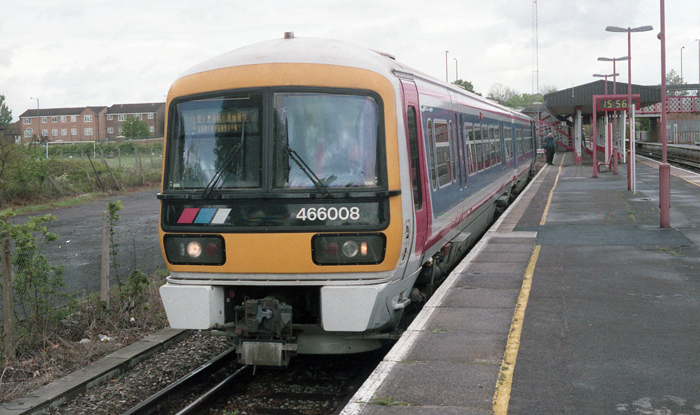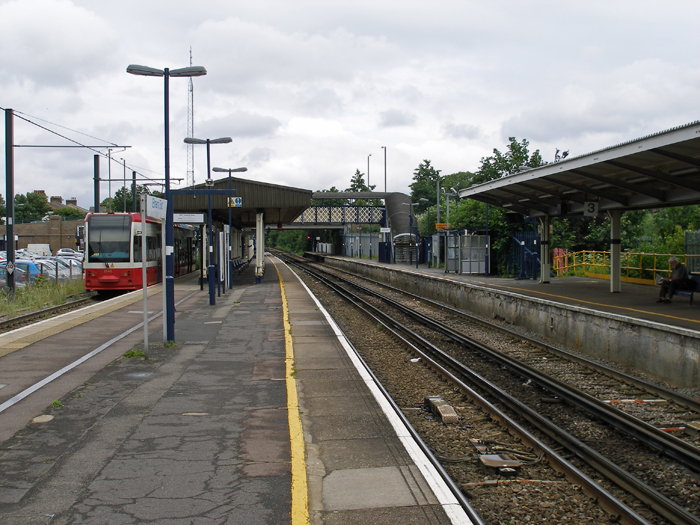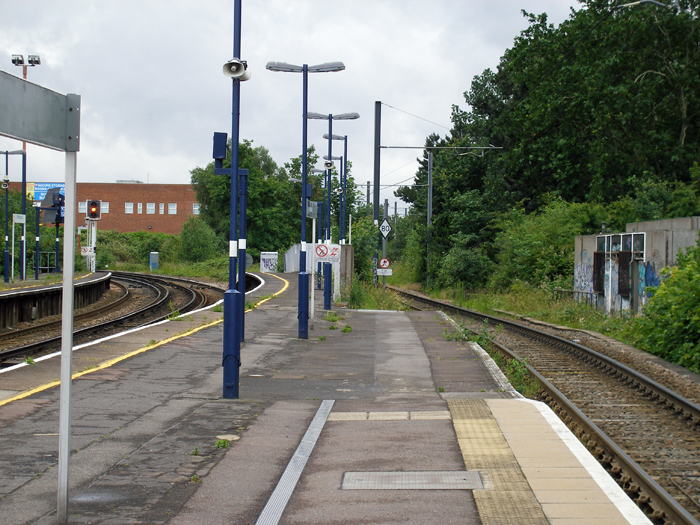
In 1941, a large middle chunk of the "down" side canopy was destroyed by German bombs, and the southern end of the "old house" was also taken out. The remaining, larger portion of the latter was still standing after the conflict, as was the "up" building of 1882. Further structural alterations came in the wake of the December 1950 decision not to pursue double-decker trains to relieve overcrowding, but to instead run ten-carriage formations. This involved large-scale platform lengthening across South Eastern Division suburban lines, Exmouth Junction providing the precast concrete components for the extensions. At Elmers End, southward extension of the "up" platform was prevented by the course taken by the Addiscombe line. As a result, works commenced in late 1956 to re-route this double-track line to east of the signal box, so it now merged with the sharp curve from Hayes. Both "up" and "down" platforms were subsequently extended southwards in 1957, the new sections being equipped with concrete bracket lamps. The latter were fitted with BR "Sausage" Totem name signs, whilst their earlier counterparts on the existing platform sections retained SR "Target" boards.
In 1961, remedial works on the platform canopy damage sustained during World War II was completed. This involved dismantling that southern section of the "down" canopy which had become isolated from the buildings as a result of the bombing raid, and erecting a new structure of about 150-feet length. This was erected to a design which had become standard at the time, comprising a V-shaped cross section, such canopies having also come into use on the lengthened platforms at London Victoria and the rebuilt station at St Mary Cray. The canopy attached to the "old house" of 1864 received a simplified valance, and the "up" side canopy was rebuilt from its semi-circular shape to a triangular outline with plain valance.
Public goods traffic at Elmers End ceased on 6th May 1963 and, thereafter, continued decline was the order of the day. Before this decade had been seen out, the original station building on the "down" side (the "old house" of 1864) was demolished. It was replaced by a small bus shelter-style affair, but the canopy of 1961 was retained. Then, in 1973, the "up" side main building was gutted by a mysterious fire, as per a number of historic South Eastern Division station structures over the years, which resulted in its demolition. In the following year, a glazed box-like structure appeared in its place, this being built to yet another standard British Rail design which also came into use at Chelsfield and Maze Hill stations.
In spite of the structural demolitions, there was still some interest at Elmers End for the railway historian. The Mid-Kent Line remained as a pocket of mechanical signalling on the South Eastern Division suburban network, retaining traditional signal boxes controlling semaphores. This was ebbed away on 27th September 1975, when the Hayes branch was brought under the control of the then new London Bridge panel; signal boxes at Hayes and Elmers end were closed and colour lights replaced sempahores. The line to Woodside and Addiscombe retained mechanical signalling.
There have been a few casualties of the Southern Region electrified third rail network. Early closures were the Crystal Palace High Level branch, which ceased to operate in 1954 and, in Central Divison territory, the Ardingly branch from Haywards Heath to Horsted Keynes, which closed in 1963. South Eastern Division suburban lines were to be dealt another blow in 1983 when, on 13th May of that year, the double-track through line between Woodside and Selsdon was closed to traffic. Consequently, that left Elmers End at the junction of two dead end routes, those to Addiscombe and Hayes. Sadly, this was not the end of network pruning, and the fate of the Elmers End to Addiscombe branch was sealed on 21st July 1994 when Royal Assent was granted for the "Croydon Tramlink Act". This detailed an 18-mile (29-KM) standard gauge light rail network serving the London Boroughs of Croydon, Bromley, Merton, and Sutton, which terminated at its western extremity at Wimbledon and, in the east, Beckenham Junction, Elmers End, and New Addington. The last services along the Addiscombe branch ran on 31st May 1997, closure allowing construction of the Croydon Tramlink to proceed. The "up" bay platform face at Elmers End was retained for Tramlink use, light rail services commencing on this part of the 38-stop network on 29th May 2000.
The future of the existing Lewisham to Hayes line looks decidedly bleak. A public consultation made in 2014 about the extension of the Bakerloo Underground Line to Lewisham and Hayes received a very favourable response. Between Lewisham and Hayes, this is intended to replace the National Rail line, spelling the end of the original Mid Kent Railway of 1847. Should the scheme be approved, the earliest year of construction is envisaged as 2023, the first trains running over the extension seven years later.

Track layout of 1960, showing the shifting of the junction between Hayes and Addiscombe lines to east of the signal box. A facing crossover on the Hayes branch, beyond the scope of the diagram, allowed trains from the "up" line to access the "down" bay platform. Click the above for a larger version. © David Glasspool

Seen in the final month of operation of the Addiscombe branch, "Networker" No. 466008 is seen in the "up" bay forming a shuttle service to that terminus. The signal box at Addiscombe had been destroyed by an arson attack, so the branch was operating under the "One Train Working" single line principle. By this time, the "up" canopy's timber valance had been replaced by corrugated metal. © David Glasspool Collection

A northward view shows the "up" bay platform to be occupied once again, but this time by a tram powered from 750 Volts D.C. overhead wires. The V-shaped canopy on the right dates from 1961. © David Glasspool

Taken fifty years after the photograph on the previous page, there has been much change south of the station, vegetation having taken a strong hold. Curving sharply left is the Hayes branch, whilst departing on the right is the single line of the Croydon Tramlink. © David Glasspool
Return to the Kent Rail Homepage or alternatively, check for Updates.
Website & Copyright information - Links - Contact the Webmaster